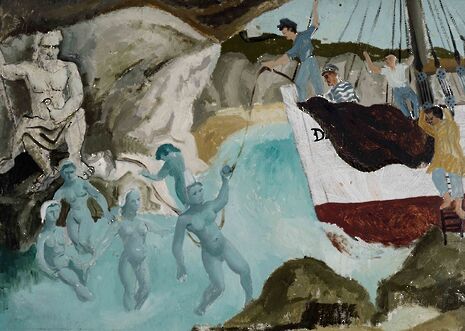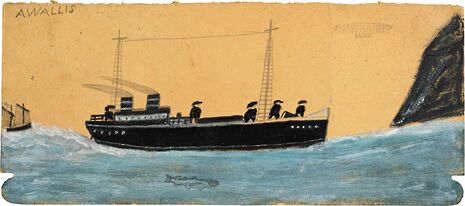Review: From Sea to Shore
Kate Little reviews paintings by Alfred Wallis and Christopher Wood at the Fitzwilliam Museum

Alfred Wallis once asserted that “each boat has a soul, a beautiful soul shaped like a fish, so the fish I’ve painted aren’t fish at all”. His sentiment radiates from the pieces displayed in Sea to Shore, conveying the experiential depth of his beloved ocean. Born in Devon, and living both on the ocean and the Cornish coastline, Wallis spent the majority of his life as a fisherman, and later a scrap-metal merchant, based in St Ives. It wasn’t until the death of his wife in 1922 that he turned his hand to painting in order to curb his loneliness. On a summer trip in 1928, artists Ben Nicholson and Christopher ‘Kit’ Wood stumbled upon Wallis’s open back door and discovered “some paintings of ships and houses on odd pieces of paper and cardboard nailed up all over the wall, with particularly large nails through the smallest ones.” Nicholson and Wood introduced Jim Ede to Wallis’s work, which subsequently garnered attention in London, with many finding their way into Ede’s Kettle’s Yard.
“Ships shrivel in the presence of fish, vulnerable in turbulent oceans and thrust toward precarious coastlines.”
Wood was particularly taken by Wallis’s approach, spending time studying his technique and unusual material choices. Wallis used only what he found. Nicholson recalled that “he would cut out the top and bottom of an old cardboard box, and sometimes the four sides, into irregular shapes, using each shape as the key to the movement of the painting, and using the colour and texture of the board as the key to its colour and texture.” Using house or boat paint upon various rough and textured surfaces provides Wallis’s works with a rich experiential element. Viewing them up close also proves to be an unexpected encounter: frayed edges curl up towards the eye and, if you press your face right up to within an inch of the glass (as I cannot help but do), rusted nails are evident between swathes of greens and blues. ‘Motor vessel with airship and shark, n.d.’ will even reveal the child-like pencilled teeth of a shark grinning at back at you as it lurks beneath an unknowing ship. Ede noted that Wallis had the “power to convey the exciting continuity of actual development; the sea-feeling, the ship-feeling […] His painting is felt […] It is the immediate welling up of his vision, rich in actual experience.” The pieces displayed in Sea to Shore are imbued with this sense of experience: ‘Schooner on a blue sea’ depicts a ship cradled precariously in the bowels of a luminous, blue ocean, while ‘Two ships with brown-green sails in rising sea’ sees its ship partially encroached by water. The texture of the ocean is coarse and violent: white overlays green in jagged, sweeping motions. Wallis often ignored perspective – an object’s size was dependent on its importance in relation to other components present. ‘Land, fish and motor vessel, c.1932-37’ sees fish equivalent in size to the ship, depicting the latter’s insignificance within the colossal ocean. Wallis’s pieces exhibit a fraught relationship between machine and wilderness. Ships shrivel in the presence of fish, vulnerable in turbulent oceans and thrust toward precarious coastlines.

Equally, the pieces by Christopher Wood confer the perilous correlation between ocean, ship and land. His naïve art explored post-impressionism and primitivism, before he finally created a personal ‘faux-naïve’ method. His child-like approach echoes that of Wallis, refusing naturalistic perspective and exploring in the two pieces included in the exhibition, the hazardous interaction between man and nature in Ulysses and Sirens (or Mermaids), 1929.
While each of the pieces delves into the essence of the ‘sea’ and ‘shore’, the exhibition is minimal and oddly cold. Positioned on the ground floor of the Fitzwilliam Museum – within the ‘European Pottery’ room – the display is easily missed, positioned upon a short fragment of white-painted wall. Despite being marketed as paintings by Alfred Wallis and Christopher Wood, the plural is hardly deserved as the latter has a meagre two pieces tacked onto the end of the display. The organic presentation for which Kettle’s Yard is widely renowned is sadly lost here, its essence absent in a hallway-like room centred on pottery. The paintings are emblematic of the rough collision between the sea and the shore, but are ultimately lost in their incongruous surroundings.
Sea to Shore is part of Kettle’s Yard collection at the Fitzwilliam Museum until 27th August 2017. Admission free
 News / Cambridge academics stand out in King’s 2026 Honours List2 January 2026
News / Cambridge academics stand out in King’s 2026 Honours List2 January 2026 Interviews / You don’t need to peak at Cambridge, says Robin Harding31 December 2025
Interviews / You don’t need to peak at Cambridge, says Robin Harding31 December 2025 News / AstraZeneca sues for £32 million over faulty construction at Cambridge Campus31 December 2025
News / AstraZeneca sues for £32 million over faulty construction at Cambridge Campus31 December 2025 Comment / Plastic pubs: the problem with Cambridge alehouses 5 January 2026
Comment / Plastic pubs: the problem with Cambridge alehouses 5 January 2026 News / Cambridge businesses concerned infrastructure delays will hurt growth5 January 2026
News / Cambridge businesses concerned infrastructure delays will hurt growth5 January 2026








